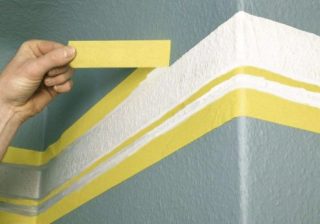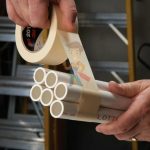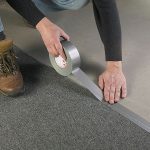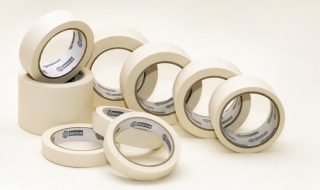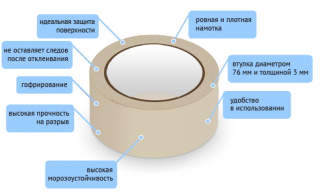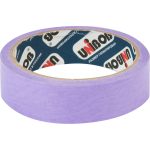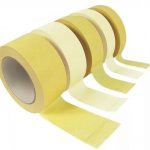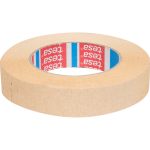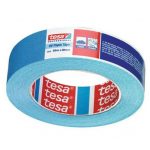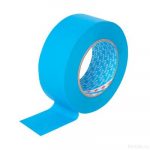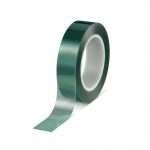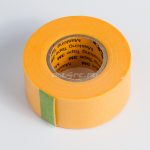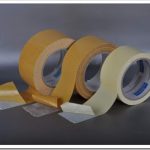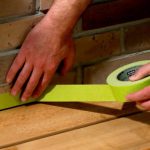In numerous painting and installation works, masking adhesive tape is used - masking tape. The device closes seams and joints, prevents contamination of tiles, wood, stone adjacent to the seam.
Description of masking tape
The adhesion of the adhesive tape is determined by the nature of the adhesive. Used rubber, acrylic, foamed polyurethane and even bitumen glue. It should be borne in mind that each option is designed for a specific type of work. Therefore, bitumen or polymer tape cannot be considered better, for example, acrylic.
Acrylic-based scotch tape is more often used to seal not the joints, but the edges to prevent contamination when filling with sealant. In such cases, it is necessary that the protective film peels off easily without damaging the material. It is unreasonable to take an option with high adhesion for this.
Applications
- filling joints and seams for the purpose of leveling the surface;
- fastening of any parts: plasterboard and skirting boards, light details to a wooden structure, mirrors to a plastic surface, a sheet of paper to a book;
- fixation - for example, when you need to fix the long end of a tape measure, hold several parts that need to be placed in a different place one by one;
- security - strengthen the container with adhesive tape;
- protection of the adjacent surface - tape and film are used to prevent the ingress of glue, paint, varnish on wallpaper, tiles or laminate;
- demarcation - with scotch tape they outline the area in which painting or varnishing is performed, which allows you to maintain clear boundaries.
Masking tape is also suitable for making external and internal stencils.
Non-standard areas of use:
- a strip of duct tape performs stand role: small items are glued to it so as not to lose;
- tape is glued places where you want to make a hole in a material that is soft, delicate or hard, but fragile, like tiles, glass, expensive fabric wallpaper;
- crepe tape make markupeg in warehouses to mark zones;
- material can paste over windows instead of paper strips;
- crepe apply for temporary sealing of joints and seamsas well as to protect the sealant until it hardens.
Colored tape of different widths or even with a pattern is used as a finishing material - decor on the walls.
Dimensions and main characteristics
- width - from 6 to 50 mm, a crepe with a width of 75 mm is also produced;
- roll length - from 20 to 70 m, there is a tape 150 m long;
- thickness - from 105 to 140 microns.
Roll weighs from 30 to 700 g.
- adhesion - depends on the degree of stickiness and the purpose of the material, the indicator is the higher, the longer the tape should hold the parts together;
- strength in the direction of the grain in the tape - the scotch tape is highly stretched, but practically does not tear;
- temperature Range - from -10 to + 120 ° С, and these are the temperatures at which the tape can be glued;
- steadiness to the action of dampness, frost, ultraviolet radiation;
- compatibility with paints, varnishes and other finishing materials;
- ability to delete crepe from the surface;
- high elasticity - the tape is easily wound on objects of any configuration.
The different composition of the base and the adhesive provides the appearance of specialized materials, with high water resistance, for example.
Varieties of material
Most often, the basis of the masking tape is paper. This is due to the fact that this type of adhesive tape is used for temporary bonding and for edge protection. Used by crepe paper: it is much denser and does not get impregnated with adhesive.
Several different versions are produced.
- Scotch tape for clear lines - budget and super tape. The base of the first is ordinary paper, the second is thin Japanese paper, the thickness of a cigarette. Such a tape is extremely light, outlines any, even curved, contours. The adhesive tape is very easy to detach from the surface. It does not leave marks on plastic, wood, stone, paper wallpaper.
- For delicate surfaces - has a low level of adhesion. It does not attach tightly and detaches very easily. The base is plain paper, but thin. It can be glued to wallpaper, even thin silk ones, the tape does not leave traces.
- Radial - option with increased elasticity. It does not curl or wrinkle when creating curly lines with smooth, complex contours. Such a crepe does not break on lateral bending. It is used for decorative purposes.
For delicate surfaces For clear lines Radial - Heat resistant - used in areas where hot drying is required, for example, when painting a car body. Heat-resistant crepe can withstand temperatures of + 110– + 150 ° C for 1 hour. Normal works only at + 60 ° С.
- Moisture resistant - or even waterproof, used for sealing window seams. It is quite firmly attached to the plastic. However, it is not difficult to remove it: just warm it up with a hairdryer.
- UV resistant - masking tape for windows, intended for external work. It is resistant to both sunlight and frost, as well as dampness and contact with water - during rain or snow.
UV resistant Water resistant Heat resistant - Durable adhesive tape - it is used in cases when it is necessary to connect plates and sheets or close the seams for a long time - up to 30 and even 60 days. Usually crepe is placed on solid, smooth surfaces - stone, brick, metal, hard plastic. But there are also options for delicate surfaces. This tape does not leave marks on drywall, for example, if used for 14-24 days.
- Double-sided - can have both a crepe and a fabric base. The glue is applied on both sides. They connect surface details to each other. The fasteners are reliable and durable.
- Camouflage - a special variety used to mask rubber seals and gaskets for headlights, car windows, moldings.
Camouflage Double-sided Durable
There are also types of tape that do not have a sticky surface at all.
Criterias of choice

To find the option you want, take into account the following parameters.
- Color - sometimes it means nothing. However, there are a number of manufacturers who use color as a marking, so you need to pay attention to this parameter.An ordinary tape is marked in yellow, a waterproof version is in blue, an adhesive tape that can withstand temperatures up to + 80 ° C is green.
- Width and length - the width is determined by the nature of the work, and the length is determined by the volume. The standard roll length is 50 m, which may not be enough.
- Thickness - determines the value of the tear resistance.
- Adhesion value - for delicate surfaces and decorative work, they take thin adhesive tape with a low level of adhesion. And for sealing the seams in the window frame, you need a durable material.
Other features are also taken into account: resistance to ultraviolet light, temperature range, if it is important.
Recommendations for use

Using duct tape is simple, but it’s worth following a few guidelines.
- Before pasting surfaces are cleaned of dirt, dried and degreased... The latter is performed when working with complex surfaces, such as metal or stone.
- When sticking the tape is not twisted or bentif it is not a radial option.
- Remove fresh tape, smoothly detaching the strip from the surface. Do not make sudden movements, otherwise the material may be damaged.
- If the tape is already dry, it is first soaked in warm or hot water. Damp crepp is easily peeled off.
In some cases, wetting with oil helps, since under its action the glue loses its adhesion.
How to remove scotch marks

If there are still traces of the tape:
- Track treated with a steam generator... The composition becomes wet and can be easily removed with a sponge.
- Can stick a new tape on top and take them off together.
- Remains of glue and crepp warmed up with a hairdryer... At the same time, it dries out so much that it detaches itself.
- Any stains can be removed. alcohol-containing products, for example, a glass cleaner.
In the most extreme cases, special industrial means are used.



